The release of Thor: Love and Thunder brings with it a plethora of cosmic entities, all of which are more powerful than the majority of the Avengers. You have not seen anything yet, people.
If you thought Moon Knight was populated with gods, think again. Each of the gods in Taika Waititi’s collection of MCU characters comes from a distinct pantheon or, in some cases, comes from a completely new planet. But how many gods actually made an appearance in the fourth and perhaps biggest Thor movie? Will they play any role in the upcoming MCU events? In that case, how?
Then why? This video, All Gods that appeared or were mentioned in Thor: Love and Thunder – Explored, will address all of those concerns and more. You should be aware that the following contains movie spoilers before we continue. There is a LOT to unpack, so if you have not seen it, go watch it and then return here. Let us begin, then!
Prior to explaining further, we have a very minor request.
Please subscribe to our channel if you enjoy our work. It may seem like a tiny gesture to you, but it means a lot to us.
Thor Odinson
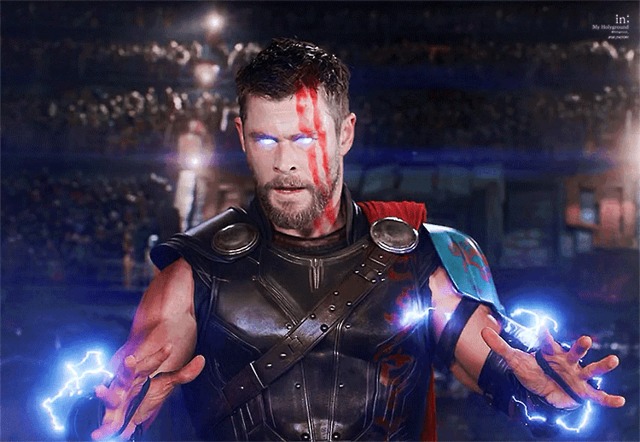
Let us get the big guy out of the way at the top of the list. What new information about Thor Odinson can we impart to you? Do not let Tony Stark convince you otherwise. He is the God of Thunder, the former King of Asgard, the “strongest Avenger,” and — we shall get to him later — possibly the strongest God in the cosmos outside of, say, Eternity. However, Thor in this film is more than simply the Thunder God, and Thor in the MCU as a whole is not the Thor from the comics.
Since the great Odinson is a wreck there, driven by alcohol, battle, and an unending struggle to escape his destiny. Since Thor still reigns as King of Asgard in the comics, this burden has had a significant negative impact on him. Even after fighting and killing some of his closest allies, obtaining the Power Cosmic, and ascending to a higher level of existence, he still feels unworthy. MCU Thor is a dude-bro of the highest order and we kind of love him specifically because of that, you guys know everything I just said about the 2 Thors is true if you know which tale I am referring to.
The first two Thor movies were among the most distinctive cinematic works in the MCU canon, but in terms of tone, they diverge greatly from the course that the films ultimately took. Since the pre-Avengers Thor was obliged to face Ragnarok, he would not have done it with as many jokes and lighthearted confidence as his post-Avengers counterpart did, Thor: Ragnarok was basically a soft relaunch for the franchise.
But after distinguishing the two, we can claim that Thor’s underlying quest for knowledge is still the same. Even when he embarked on more traditional Thor adventures with the Guardians of the Galaxy — sorry, Asgardians of the Galaxy — he found himself acting more and more like a god. When he was on vacation, Thor would spend his days in meditation and would only assist the Guardians when called upon under the most dire circumstances, kind of way a God would.
Thor’s quest in this film, however, is about creating his own destiny and regaining control over it rather than facing his fate as a God. As you can see, Thor has always had a very clear struggle ever since he first appeared in the MCU; he was a brazen young man unsuited to be King but was yet chosen for that position due to who he was. This film genuinely addresses the fact that Thor never had the chance to learn about himself, his loves, or his desires.
Besides the obvious costume connection, we only catch a glimpse of Rune King Thor in two scenes: the first is when he enchants Mjolnir to turn Jane Foster into the Mighty Thor, and the second is when he imitates Odin from the first Thor movie by using an incantation that, like Odinson, temporarily grants Asgardian children the abilities of Thor.
Additionally, as he decides to forge his own route in the film, Thor seems to have finally overcome his internal turmoil about finding a course to follow. He addresses and accepts his love for Jane and stops being afraid to take the lead. By the end of the film, Thor even picks up a few parenting tips, but that will come later. For the time being, let us just say that given the current course of events, our favourite God of Thunder is going to need some major power upgrades to defeat his next foe.
After all, in comparison to the trials that man has faced, Thor has not done much to establish himself as a superior god of the universe, but that could change in Thor 5. But now that we have discussed Thor’s part in his own film, it is time to talk about the other gods.
Rapu
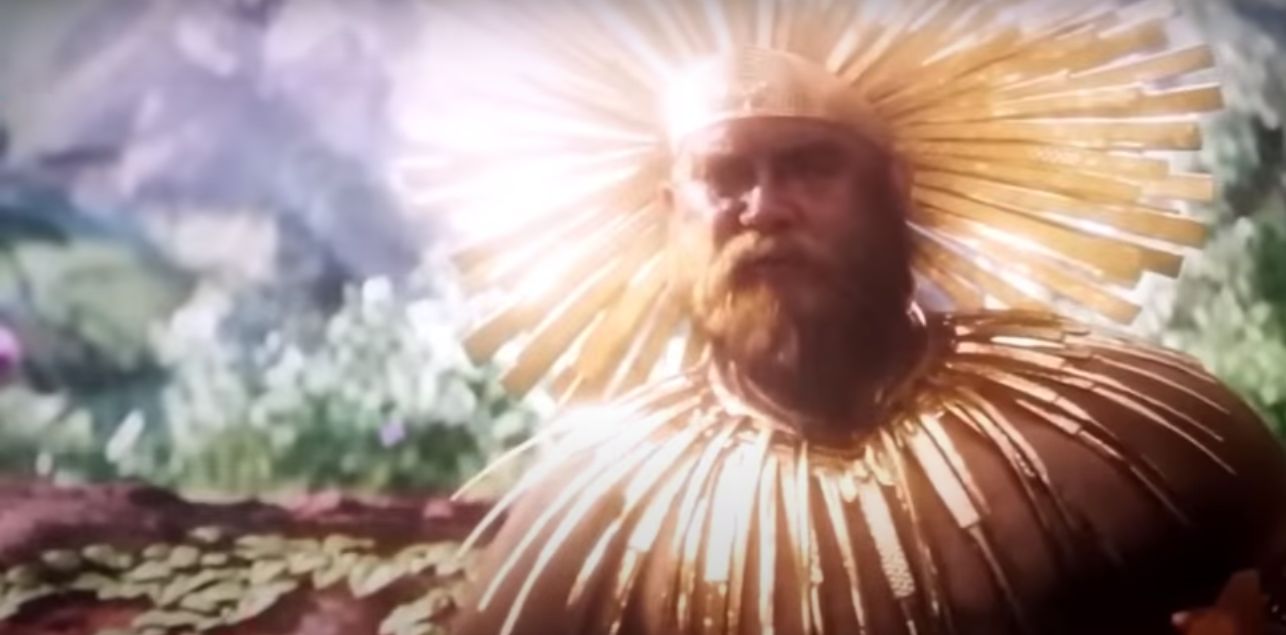
The next god on our list is the one responsible for Gorr’s nasty god-butchering spree, and that god is none other than Rapu; the arrogant, self-absorbed “Bringer of Light” of Gorr’s unnamed people. Given his title and his character design in the movie, we can deduce that Rapu was the Sun God of Gorr’s religion. When we encounter the Bringer of Light, we see that he is crowned with a halo that looks like the sun’s rays, and the medallion that Gorr wears around his neck at the beginning of the film also looks like a Sun Medallion designed with Aztec and Mayan influences.
Rapu is a film-exclusive god, as there is no counterpart of his in the comics, or in the real world, and he only really serves a single purpose in Thor: Love and Thunder; that is to spur Gorr’s massacre by leaving him disillusioned to the point of lunacy. The movie begins with Gorr cradling his dying daughter in his arms and carrying her across the desert for days, praying to Rapu for water and sustenance, but to no avail.
His daughter passes away in his arms, and he can do nothing about it. He eventually ends up stumbling across a lush oasis where he spots the celebratory fruits of Rapu and starts eating them like a mad man, but is faced with his God Himself. Gorr pleads with Rapu to save his people because he was the last of them; their planet was dying, his people were already dead, and yet all Rapu cared about was being worshipped “the right way”.
Rapu’s utter nonchalance towards the fate of his followers and Gorr’s daughter is what causes him to renounce the gods and vow to kill them all. The only notable thing that Rapu managed to accomplish in his short screen time is killing the unnamed wielder of the MCU version of the Necrosword, and even that ended up biting him in the butt, because the Sword ended up corrupting Gorr, who began his divine genocide with Rapu’s blood.
Lady Sif
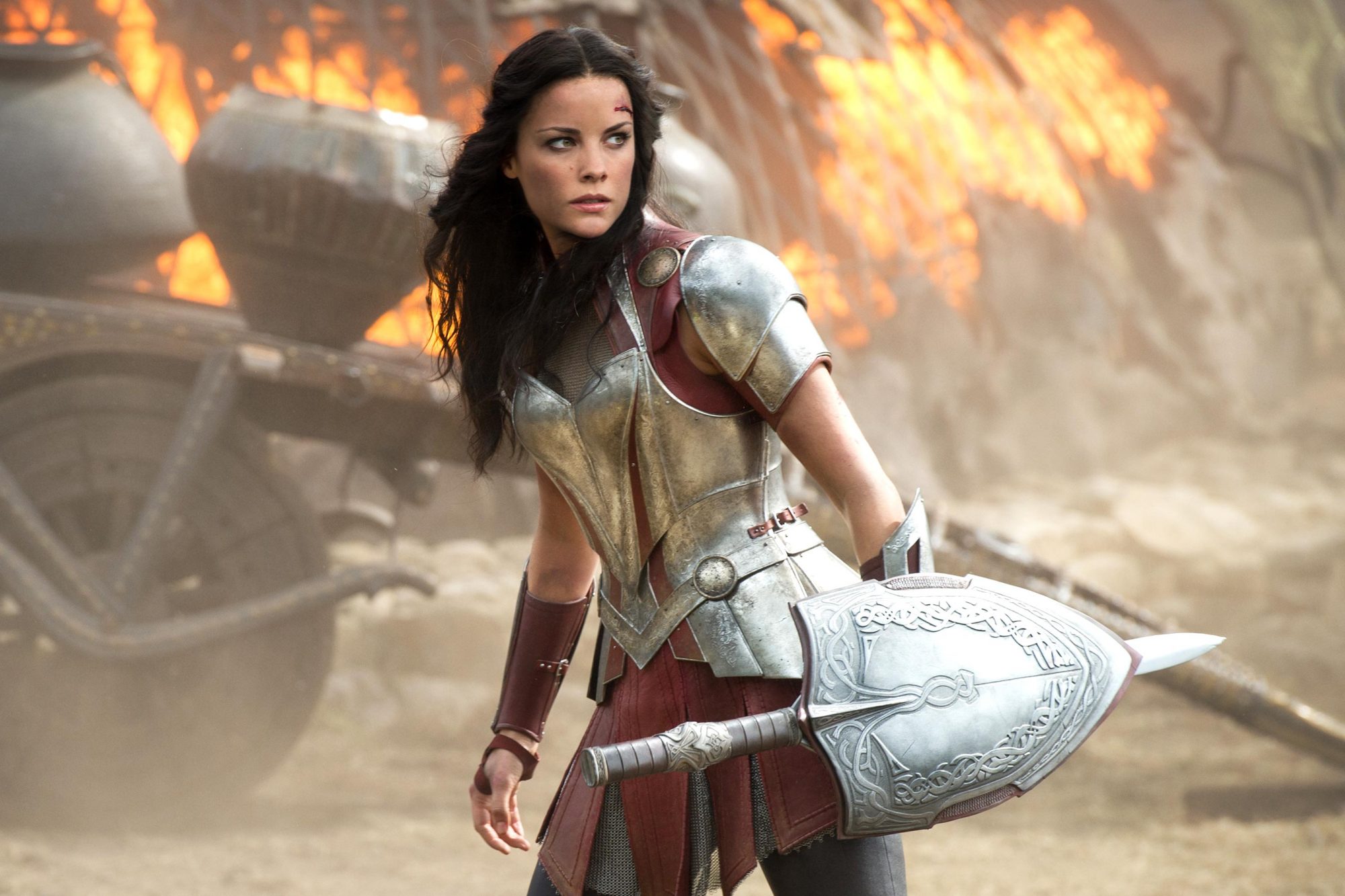
Jaimie Alexander makes her return to the MCU as Lady Sif in Thor: Love and Thunder after missing out on the events of Ragnarok; though perhaps that was for the best, given what happened to Asgard in that movie. Sif is one of those characters whose story has changed a LOT over the years. In the comics, as in Norse mythology, Sif is Thor’s primary love interest.
She is the Norse goddess of the Harvest and Family, and has sired a daughter called Thrúd with him in real-world myths. In the comics, things are more complicated thanks to Thor’s status as a certified party-boy, and in the MCU, Sif is the distant, wistful, one-sided lover who never gets the man she has always wanted; instead being forced to help the woman that he truly loves.
So, after Sif helps Thor get the Aether out of Jane Foster and repel the attack of the Dark Elves, she becomes a somewhat withdrawn character, focused solely on the missions that were being handed to her by “Odin”- who was actually revealed to be Loki in disguise. Sif became a surprising mainstay of the Inhumans series, where she was sent to Planet Earth to capture Lorelei and ended up losing her memory in the process of discovering Kree presence in Midgard.
After helping a back-from-the-dead Phil Coulson and the Inhumans defeat the Kree invaders and taking Lorelei back to Asgard- not in that order- Sif was banished from her home planet by Loki just in time for Ragnarok. After being banished, she wandered the universe and was actually blipped out of existence when Thanos first snapped his fingers. She was brought back by The Hulk’s snap, and thereafter continued with her godly duties on a different planet, presumably Falligar, because that is where she sends Thor a distress signal from in Love and Thunder.
Sif was on Falligar when Gorr attacked the planet and its gods, and she ended up fighting the God Butcher and losing an arm to him in the process. Thor reached her just as she was about to die, and she had accepted her fate as well; up until he told her she won’t be going to Valhalla because she didn’t technically die in battle, and so Sif was given emergency first aid and sent to New Asgard for recovery.
Though she doesn’t join Thor in his final battle against Gorr, she does continue to serve New Asgard as the new weapons master. Her scene with Axl is actually quite reminiscent of Jamie Lannister sparring with Sir Bronn of the Blackwater, except it is a lot less swear-heavy for obvious reasons. Sif will most likely return as a mentor figure in Thor 5 and might even get her wish of getting into Valhalla as a true warrior as well. And speaking of Warriors…
The Warriors Three
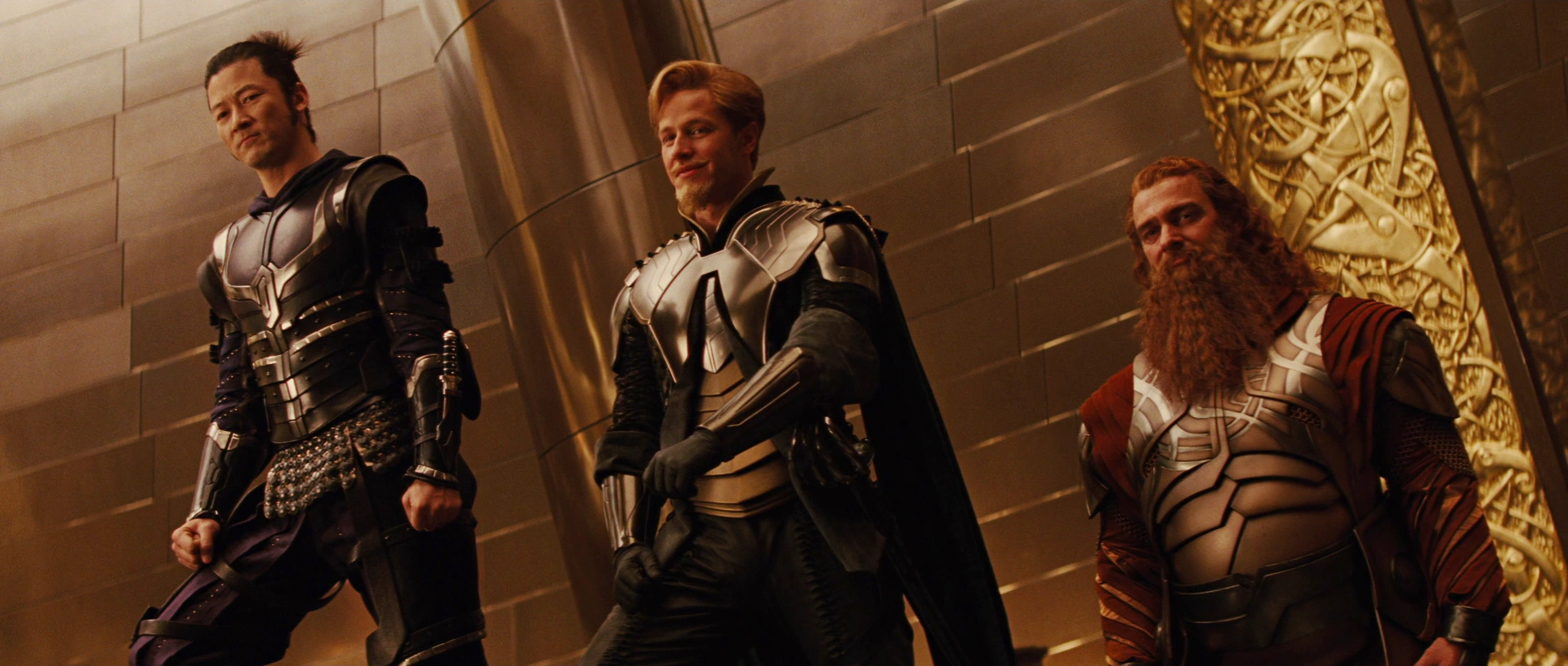
Volstagg, Hogun and Fandral got a nod in Thor: Love and Thunder thanks to the many flashbacks that were facilitated by the dulcet tones of one Korg the Cronan. When Korg was recounting the story of Ragnarok to the children of Asgard, he brought up the fact that Hela killed Thor’s closest friends, that being the Warriors Three. This dynamic trio of rough-necked but honor-bound Aesir has been with the Odinson since the beginning of his journey.
Who can forget the camaraderie they shared in the first Thor film? Volstagg is the best friend that we all deserve! But that being said, they didn’t serve much of a purpose other than being used to further the narrative of Thor overcoming his personal losses and becoming a true god. We were hoping we’d get a glimpse of them at Valhalla towards the end of the movie, but it looks like that’s going to have to wait for Thor 5. And speaking of Valhalla…
Mighty Thor
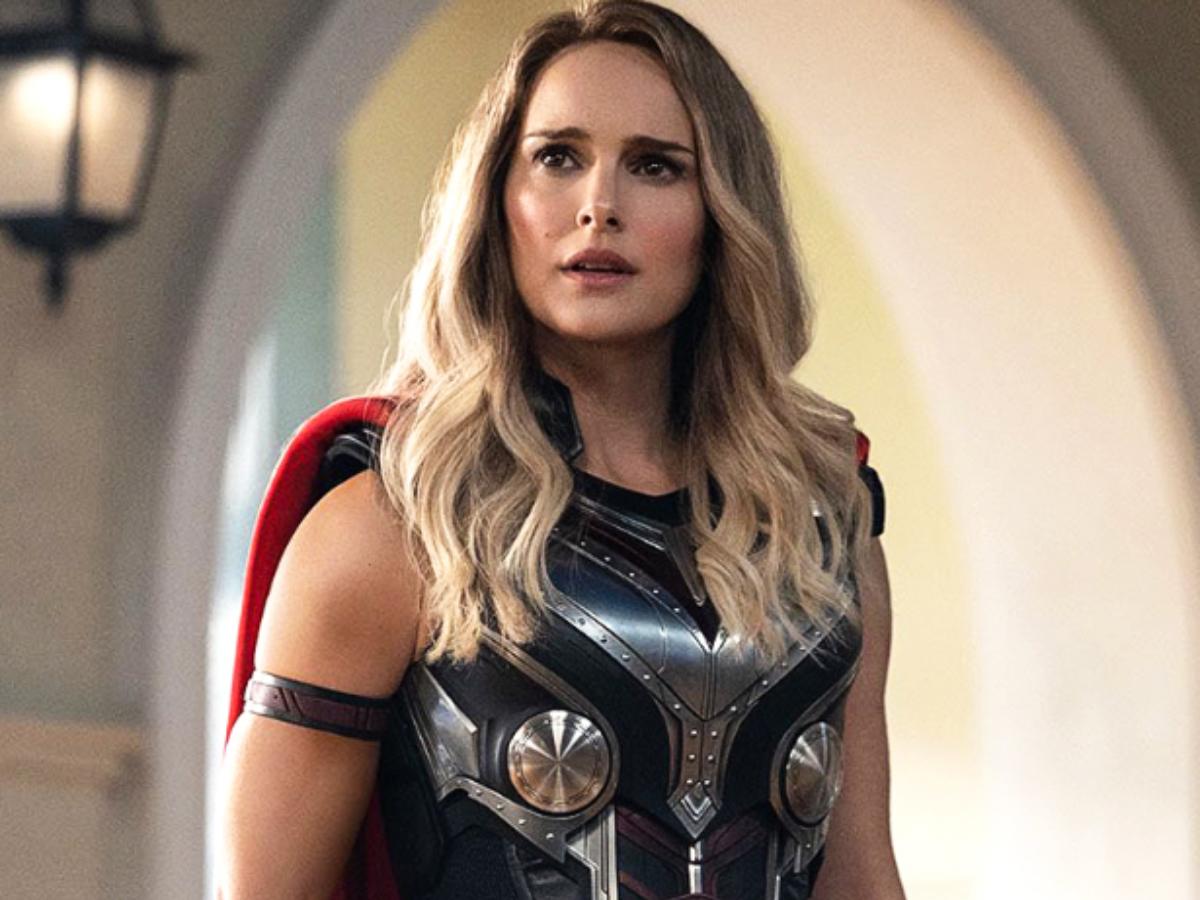
Natalie Portman made her proper return to the MCU in what was, ironically enough, her swansong from the Thor franchise. Taika Waititi decided to adapt the events of the 2014 Marvel Comics storyline “Original Sin”, which begins with an investigation into the death of Uwatu the Watcher.
Original Sin is where Gorr the God Butcher technically makes his debut, because it is the sight of one of the most-iconic panels in modern Marvel history; that being the panel where Nick Fury tells Thor that Gorr was right, causing him to lose his own worthiness which opens up the path for Jane Foster becoming the Mighty Thor. The movie follows a similar path in that Jane contracts cancer and then comes into contact with Mjolnir and gains the power of Thor; the major difference in both portrayals is that in the comics, Jane got the hammer because she was worthy, while in the movie, she got it because of a protection spell Thor unwittingly put on Mjolnir which was activated when Gorr showed up to New Asgard.
Jane has a hard time being a superhero at first, what with her horrifyingly cheesy catchphrases like “Let’s bring the rainbow” and “Eat my hammer”, but she is surprisingly good at handling Mjolnir and even better at channelling the power of Thor than perhaps the man himself. What’s cooler about her version of the character is that she can use Mjolnir has a melee and a projectile weapon, giving her superiority over long and short range combat; something Stormbreaker has a tough time accomplishing.
Sadly, unlike the comics, Jane Foster dies at the end of the movie because using Mjolnir ends up causing her cancer to speed up, and after reconciling her feelings for Odinson, she decides to go out like a true space Viking; in battle, beside the one she loves. Jane Foster’s story might not end here, though, because in the final post-credit scene of Love and Thunder, we see her getting welcomed into Valhalla but the man who is next up on our list.
Heimdall
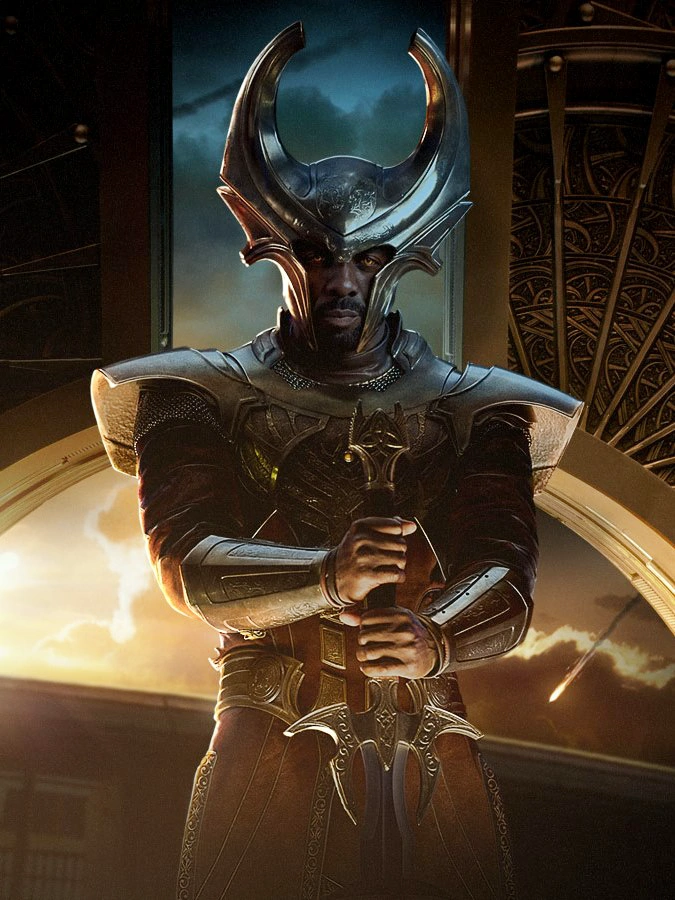
If Kevin Feige can pay Idris Alba to keep appearing for like 20 seconds in every Marvel movie, we’d be completely okay with that simply because Heimdall is one of our favourite characters from the MCU. The stoic former protector of the Bifrost pops up at the very end of the film, inviting Jane Foster to Valhalla now that she had effectively become an Aesir herself.
If you’re wondering how Heimdall ended up in Valhalla in the first place, don’t forget that he spent most of his life being a golden-eyed badass and was the last line of defence for the people of Asgard before Hela and Surtur burned it to the ground during the events of Ragnarok. Heimdall was last seen in Avengers: Infinity War aboard the Asgardian Vessel that was carrying most of his displaced people.
He gave up his life doing battle with Thanos and his Children by sending Bruce Banner to Earth to warn the Avengers about the Mad Titan’s approach. Though his primary role in this movie was to say “Welcome to Valhalla” to Jane Foster with that soothing baritone of his, we’re confident that Heimdall will play a small role in Thor 5 as well. But on the off chance that Feige can’t scrounge up enough dollars to pay Alba for another 20 second appearance, we don’t have anything to worry about, because Heimdall’s shoes have already been filled within the MCU by none other than his own son!
Astrid Heimdallson aka Axl
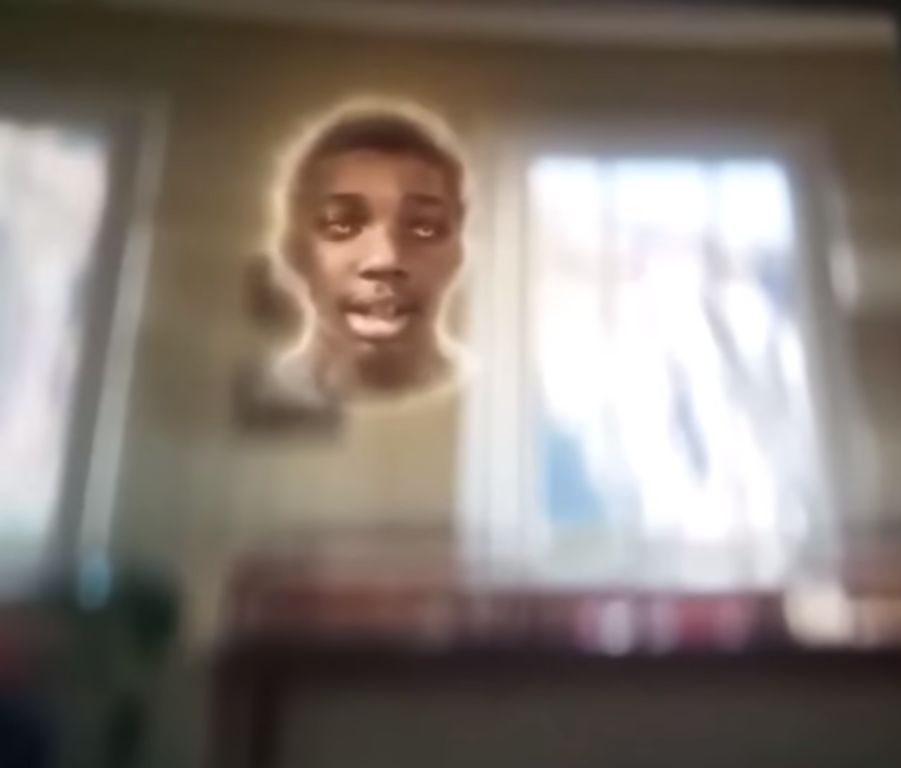
Thor: Love and Thunder continues the MCU’s push towards the Young Avengers, and we might have just seen their intergalactic wayfarer in the form of Astrid Heimdallson- sorry, Axl- who is, as his name suggests, the son of Heimdall. This is a big departure from the comics, where Heimdall died without giving birth to any discernible progeny, as it alters his legacy from the comics and real-world mythology quite a bit.
But on the flip side, it works out beautifully in favour of the story that Taika is trying to tell with Love and Thunder because Axl- whose name is inspired by the lead singer of Guns N Roses- is the spitting image of his father in thought and action. He has inherited Heimdall’s All-Sight which allows him to connect with a chosen few across anywhere in the universe.
He uses this power to contact Thor after Gorr kidnaps dozens of children from New Asgard in an attempt to goad the Odinson into action. He has also inherited his father’s calm, objective and deductive demeanour as he is able to see through most of the self-assuring crap that Thor and Gorr throw at the children and keep his mind focused solely on the survival of his peers.
In battle, Axl has proven himself a worthy opponent, being able to wield the Power of Thor for a brief period of time with unprecedented efficiency; so much so that Thor even named him General Axl in the climactic fight against Gorr and his shadow monsters. At the end of the film, we see Axl training with the one-armed Lady Sif as one of the future defenders of New Asgard, thanks to an edict issued by King Valkyrie. We can’t wait to see Axl back in action in the eventual Young Avengers movie, but till that time comes around; let’s talk about the King he serves, shall we?
Brunnhilde/King Valkyrie
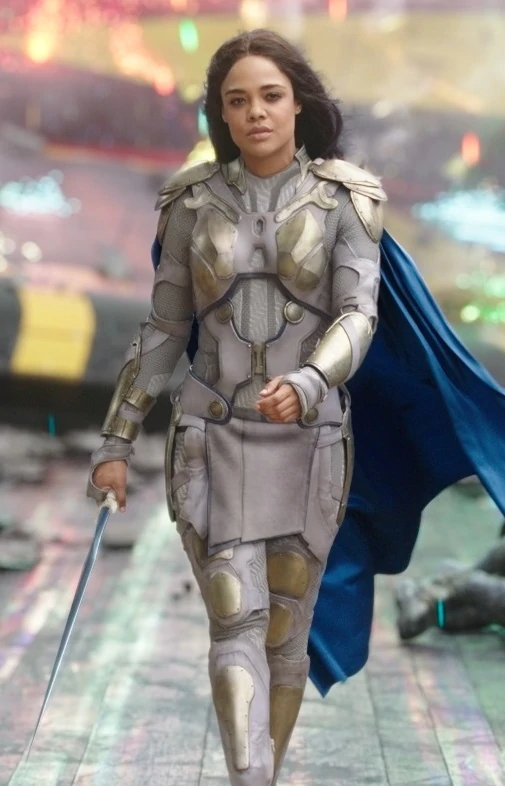
Hulk’s favourite Angry Girl is going through a bit of a power nausea in Love and Thunder. Tessa Thompson’s Valkyrie was one of the best inclusions to Thor: Ragnarok. Her character’s fierceness and vulnerability combined with a rather badass costume and move-set quickly made people forget that Brunnhilde was supposed to be a buff blonde in the comics.
But after everything that had happened to her people following the destruction of Asgard and then the Statesmen, she kind of withdrew into the same shell that Thor did during Endgame; though his case was far, far worse. But after joining in the climactic battle against Thanos’ forces and giving us the original Girls Get It Done moment- sorry, Boys- Valkyrie became a much more important character in the MCU; because, if you guys somehow forgot, Thor made her the King of New Asgard before leaving with the Guardians.
And Love and Thunder shows us just how excited- or rather frustrated- that job has made her, which is very evident in her Old Spice commercial shoot. Valkyrie loves her people and loves being King, but she longs to return to the battlefield and fight as a warrior again, which is actually very similar to the arc Thor had in the comics and the movies up until Endgame. Thor’s life’s struggle has been reconciling his purpose as a warrior with his duty as a King, and in the comics at least, that has led him to some very dark places.
Thankfully, Taika Waititi’s playful mind managed to give us a much more light-hearted take on the same storyline with the Odinson, but for Valkyrie, he chose to go with wistful. She strikes up a sisterly bond with Jane Foster in this film and is seen reminiscing about her days pre-Valkyrie extermination. Korg gives us the same note-for-note emotional breakdown of Valkyrie’s hopes and desires, like he did in Ragnarok with Thor and Mjolnir, and that actually gives us a pretty good idea of where the next movie might take her arc.
Valkyrie satisfied her warrior spirit for the moment and even got to wield Zeus’ Lightning Bolt as her weapon of choice, which would’ve felt awesome frankly. But now, she longs to be back with her sisters, and to find love again. So the next time we see Tessa Thompson in a Thor movie, she might just get a girlfriend, y’all! And we can’t wait to see who that might be. Throw down all your Valkyrie ships in the comments below!
Thor’s Family – Odin, Loki, Hela & Frigga
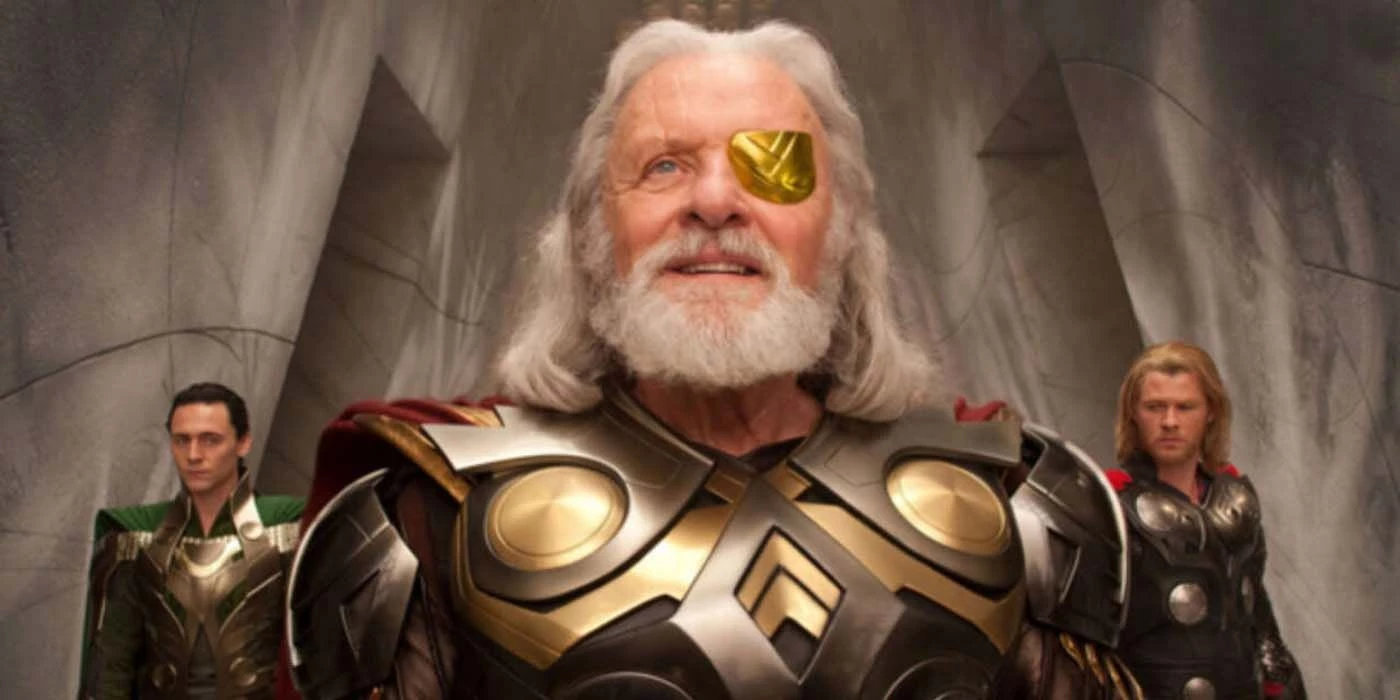
How did all four of them appear in the film when they’re all dead, you ask? Well, the first three appeared in the Asgard Theatre, of course, as the latest Liam Hemsworth and Matt Damon starrer covered the events of Ragnarok. Odin’s death was recreated with such pomp that Loki would’ve been proud of his own production, but in comes Melissa McCarthy playing Hela, and sadly, we don’t get to see the epic stage battle between these three Aesir because the play breaks and then Gorr attacks the township.
As for Frigga, well, she was invoked in both the most-badass and the most-tragic of ways, as when Korg was recounting the story of Thor’s early life, we got a shot of Young Frigga with an Asgardian Baby Carrier taking infant Thor into battle! We also saw a quick shot of her funeral pyre following the events of Dark World, but at least Frigga’s passing was treated with some dignity. Loki was invoked in not only Korg’s stories, but also Thor’s back!
As Korg was recounting the tales of the Space Viking, he spoke of his mischievous brother who seemingly died in Thor; and then died again in Dark World; and then again in Infinity War. And coming to the back reference, when Thor was unceremoniously undressed by his childhood hero- whom we’ll get to- in the middle of Omnipotent City, we saw that he had an R.I.P Loki tattoo on his back with the words “Rest in Mischief” below it; this scene also confirmed that Thor does in fact have a tramp stamp, so take that for what you will. But that’s all the ways in which Thor’s family was referenced in Love and Thunder; and given that they are all gods, they do make the cut for this list.
Falligar the Behemoth
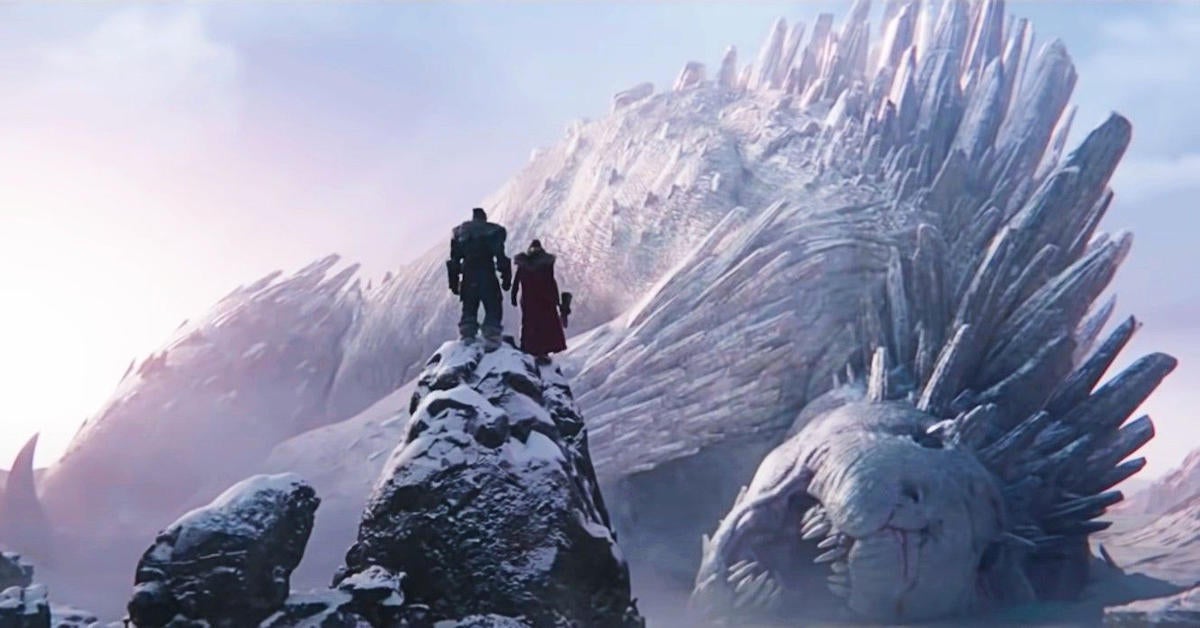
In a scene taken directly out of Thor: God of Thunder issue #3, Falligar the Behemoth is the first god we see Gorr slew that after dispatching of Rapu and embarking on his killing spree. Sif contacted Thor to come to Falligar, as we’ve already mentioned on this list, and he does so to find the Behemoth God of the planet dead and turning into God Dust as he watched his old friend battle the God Butcher underneath him.
In the comics, this scene plays out differently. The Gorr the God Butcher storyline is far more expansive and investigatory there, as Thor travels across the universe and time- through flashbacks- to track the man responsible for the disappearance of several Gods whose names ended up in the Hall of the Lost when by rights they should’ve been in the Hall of Murder. Thor travels to the locations of every god he suspects Gorr of having butchered, and the last god he visits there is Falligar; the crystalline, rat-like Protector of the Galactic Frontier.
In the comics, Falligar is something of an acquaintance of Thor. The two have passed each other many a time while flying through space, and Thor knows Falligar as the undisputed champion of the Tournament of Immortals, where he reigned supreme for 500 years straight.
So when he saw such a mighty behemoth lying dead with yet another monstrous creature guarding his body, Thor knew that this was the work of the God Butcher, and set out to find and kill Gorr once and for all. In the movie, no overt connection is made between Thor and Falligar, but it is worth pointing out that Falligar led him to Gorr; or rather Sif led him to Gorr via Falligar’s fallen body. But that’s all we have for you on this enigmatic deity, so let’s move on to some gods that we do know from outside of the MCU.
Zeus
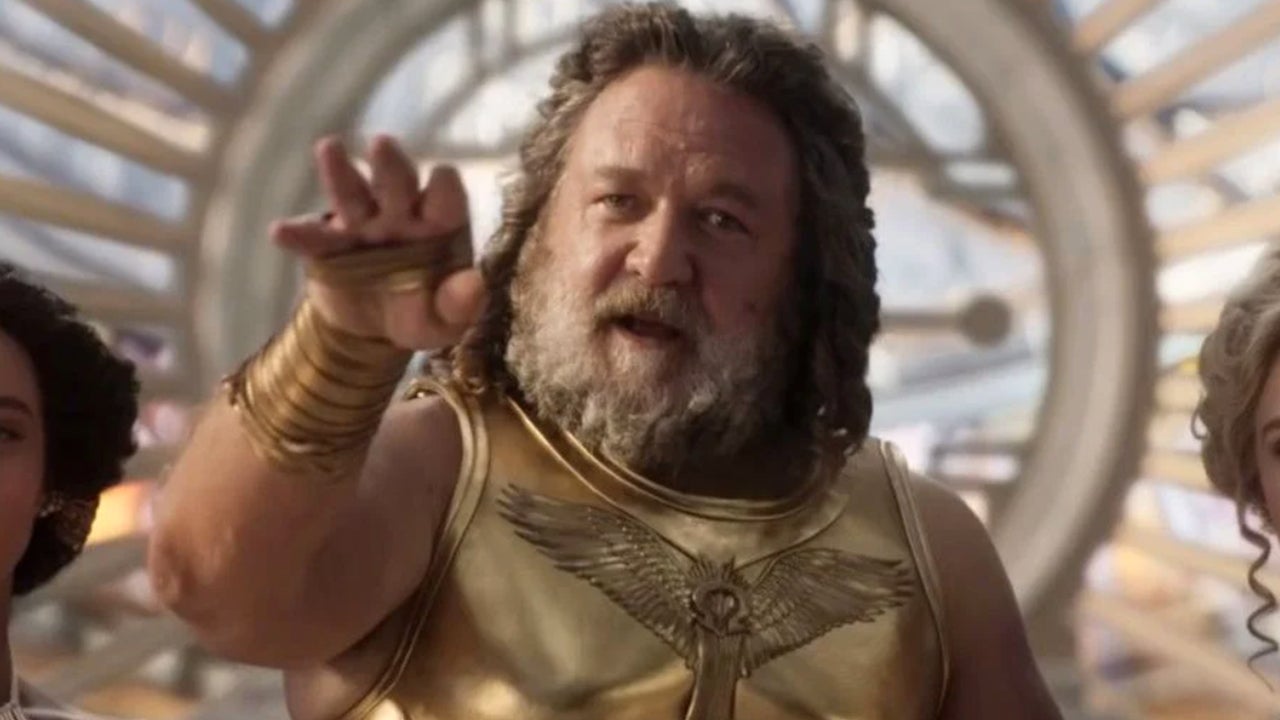
The orgy overlord of Omnipotence City and the man with the greatest entrance in performance arts history this side of Stone Cold Steve Austin, Zeus was unexpectedly more charismatic than we expected him to be when we dove into Love and Thunder; but you won’t hear us complaining. Russel Crowe went the extra mile and gave his version of the King of Olympus a Greek accent and an accompanying skirt flourish that would put most women to shame. But Zeus in the MCU is slightly different from his comic book counterpart.
Don’t worry, both of them are self-absorbed narcissists with no real concern besides their own pleasures and edicts, but in the comics, Zeus is actually much more agreeable. He has fought Thor on multiple occasions, yes, but not always as a malicious act; for example, he fought the Odinson when the latter was somehow teleported to the Trojan War, and has had to intervene in a scuffle or few between him and the character we’ll be talking about next.
But in the comics, Zeus and the Aesir manage to come to an understanding and actually end up forming an alliance that would end up spanning several millennia. The All-Father and the Sky Father, in their infinite wisdom, thought it better to merge their strengths as opposed to tearing each other down, and we gotta say, that’s a surprisingly wholesome sentiment, especially given the fact that it is Zeus and Odin expressing it.
But alas, any such alliance is going to have to come after a potentially universe-ending divine conflict, because in Love and Thunder, Thor ends up stealing Zeus’ Lightning Bolt and impaling his childhood hero before fleeing Omnipotence City with the Goat Boat. Did we say childhood hero? That’s right; in the MCU, Zeus is Thor’s primary inspiration, to the point Thor admits his Thunder gimmick is stolen from Zeus and becomes an instant fan boy during Zeus’ entrance.
Well, as the adage goes, never meet your heroes because Zeus turns out to be a right prick who is more concerned with godly hedonism than answering the prayers of the people who call out for help to the gods; hence the stealing and impaling and such. But while most of us thought him dead once we saw that sweet sweet Ichor start flowing, we were corrected by the post-credit scene which showed Zeus very much alive and looking for vengeance. And how exactly does he plan to gain revenge without his lightning bolt and with a gaping hole in his chest? Glad you asked.
Hercules

Finally! The most-iconic demi-god of all mythology has finally made his debut in the MCU, though it isn’t The Rock who is playing him; but don’t worry because Dwayne will come up in a bit. Hercules is arguably just as important as Thor is to Marvel Comics’ mythological characters precisely because he is so similar to the Odinson.
They are both sons of the All-Father of their respectively pantheons, they both have immense physical strength, and they are both renowned for their youthful buffoonery; though Hercules admittedly endures in that aspect in the comics, while Thor takes a much more darker path. But Thor vs Hercules was inevitable, because it is one of the most iconic frenemy relationships from the comics.
Heck, every time Thor and Hercules started going at it in earnest, Odin and Zeus would have to scramble to stop their sons! And that’s what makes them such good friends as well; yes, you heard us, Thor and Hercules are best-buds in the comics; though that did happen after the two slugged it out, so there’s that to consider too. Brett Goldstein’s version of the character has been tasked with killing the Odinson in the post-credit scene that he showed up in, neatly setting up an Omnipotence City vs New Asgard conflict for Thor 5.
But what we are more interested in knowing is if they’re going to keep Hercules as a bad guy or go all in on the bromance he shares with Thor in the comics, because there, they depend on each other for survival; and we’re not kidding about that. Legit, when Thor was stuck in the body of Eric Masterson, he was crashing at Herc’s place because they’re best buds. So it will be very interesting to see how Taika Waititi rounds out his trilogy of Thor films, now that the Greatest Hero of Greece has made his grand entrance to the story.
Dionysus, Artemis and Minerva – Olympians and Children of Zeus
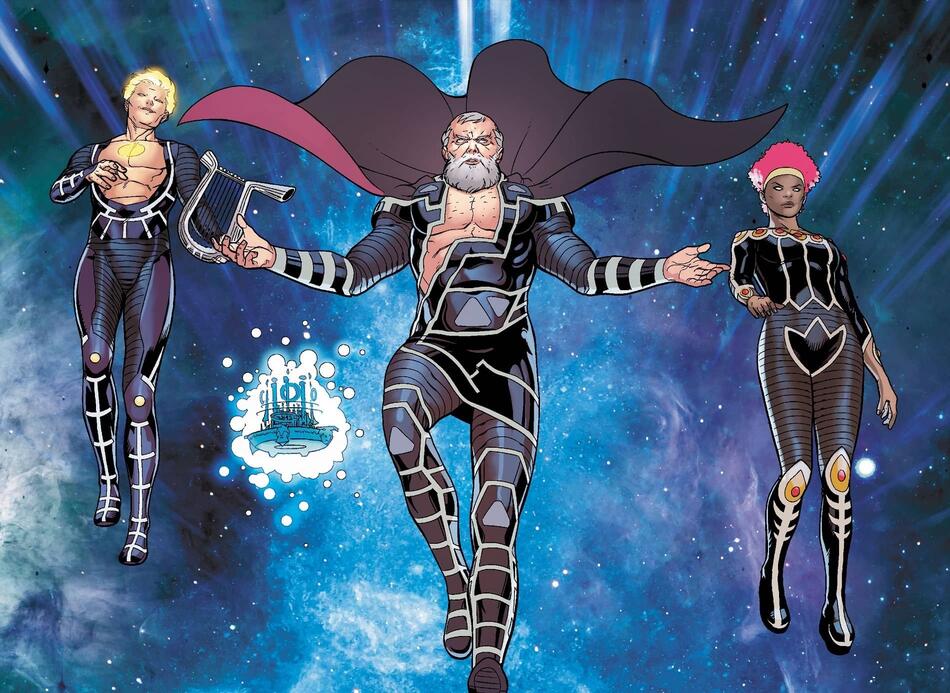
We’re just going to address the rest of the Greek pantheon with this one entry because, well, for one they don’t do much besides cheering on their dad in his petty squabble with Thor, and for the other, they have a combined screen time of maybe 2 minutes, so you know, there isn’t much to go off here. But having said that, we probably don’t have to introduce these characters to you in any capacity, do we?
We’re pretty sure most of you guys have read the Percy Jackson books, so you’re familiar with these Olympians, but we’ll go through them anyway because we have to. First up, Dionysus; the god of wine-making, fertility, theatre and ritual madness. Dionysus in Greek mythology was a figure that had a cult-like aspect to him; those who worshipped Dionysus and drank of his fruits would be imbued with an aspect of the God himself, while losing themselves to a feverish frenzy.
Dionysus is also associated with male fertility and, of course, grapes, but it’s only the last of these that is referenced in the movie that too in the form of a headgear. The fact that this madness-inspiring deity yells out, “Get him, dad!” in the middle of Zeus and Thor’s fight probably tells you all you need to know about his MCU counterpart. Next up, Artemis, the Goddess of the Hunt, the Moon, and the twin sister of the Sun God Apollo.
Though we don’t see her lyre-toting twin in the movie, we do briefly glimpse Artemis cheering Zeus on in her trademark silver armour from the stands close to his dias in Omnipotence City. It will be interesting to see how she figures into the story next; maybe Zeus sends her to help Hercules track Thor down, given that she is the goddess of hunting after all. But apart from that, we can’t see her playing too big of a role.
Last up is Minerva; aka the Roman counterpart of Athena, whose Greek name was probably avoided here to prevent confusing her with Thena the Eternal- played by Angelina Jolie. Actually, here’s a fun fact for you guys; in the comics, Thena gets her name after the Olympians pay the Eternals a visit and she meets and interacts with Zeus and Athena.
Her name change is a reflection of the pact the Eternals made with the Olympians eons ago, whereby they would serve as their heralds to their mortal worshippers. Of course, this being the MCU, we can’t exactly have 2 characters with very similar names now, can we? So it’s possible that Athena was changed to Minerva to avoid confusing her with the Eternal. Having said that, she is the Goddess of Wisdom and the chief strategist of Zeus, two factors that will definitely come into play in the next Thor movie.
Ra
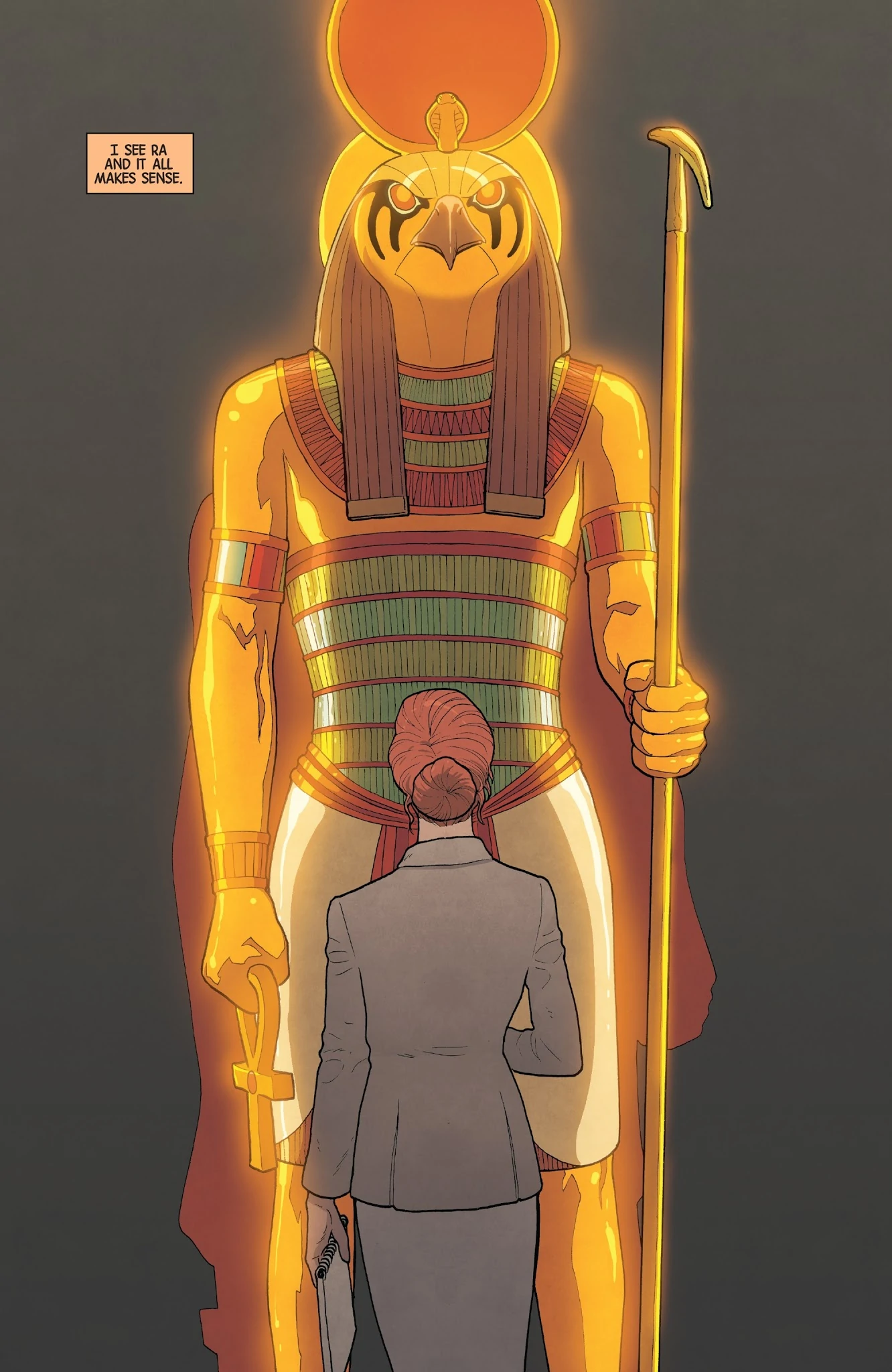
If you guys have seen Moon Knight, you’ll remember that one of the biggest reasons behind Khonshu’s conflict with the Ennead is the fact that they have abandoned their duties and retreated to the luxury of Omnipotence City. Well, that is proven correct in this film, when we get a glimpse of the glorious falcon head of the Egyptian Sun God Ra.
We saw Ra’s avatar in Moon Knight for a cup of coffee, but as it turns out, the Supreme Authority of the Egyptian Pantheon was just hanging out with his god buddies at Omnipotence City and planning massive orgies whilst his people suffered the many atrocities that the universe would come to experience at the hands of Thanos and the likes of Arthur Harrow.
Ra will be an important figure going forward in the MCU, as we expect him to be connected to the future appearances of Steven Grant’s Jake Lockeley persona and Mr. Bone-Head himself. He might even tie into the next Thor movie somehow, though we don’t have our hopes up for that one given the fact that Apollo is probably going to be the Sun God antagonist there. But we’ll have to wait and see.
Bast
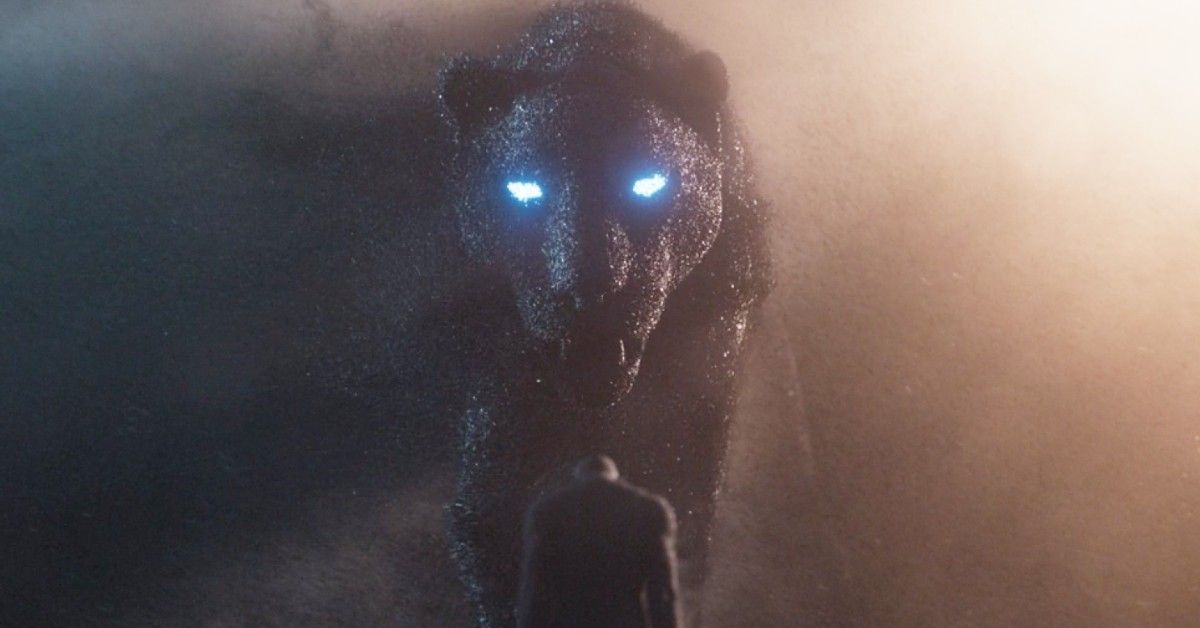
Now that we have gotten our first looks for Black Panther 2, we understand why Bast was cut from the movie but kept in the trailers; it’s one of those tricks that Marvel likes to pull to build anticipation for their projects. But, yes, technically, Bast- or rather Bastet- is a part of the Council of Godheads given her status as a member of the Ennead.
That’s right; the patron goddess of Wakanda, whose avatar becomes the Black Panther after ingesting the heart-shaped herb, is actually a member of the Egyptian pantheon! We suspect that the reason that Bast was not given a prominent role in Love and Thunder is that she will play a key role in Black Panther: Wakanda Forever. So far, we haven’t heard a lot about that film, and all we have seen are a few stills for Shuri, Okoye and one of Namor’s minions.
But what’s intriguing to us is the fact that it seems like, in the MCU, Namor is not a worshipper of Poseidon or the Sub-Mariner. Promotional material for the second Black Panther movie has been talking up the ties between Namor and the Jaguar God, which leads us to believe that originally, there were 6 Wakandan Tribes and that the Jaguar Tribe was banished way before Wakanda was even established.
There is precedence for this with M’Baku and the Jabari, and it would make sense that after being banished, the Jaguar Tribe somehow came under the protection of Poseidon- who was missing from Thor 4- and thereby went on to settle in Atlantis.
Because in the comics, Poseidon is the only Greek God who elects to stay behind when the rest of the pantheon recedes to Omnipotence City, and the comic book community will outrage if they end up making Namor completely different to what he was in the comics. So, fingers crossed, we’ll see more of Bast in the next Black Panther film.
Quetzalcoatl
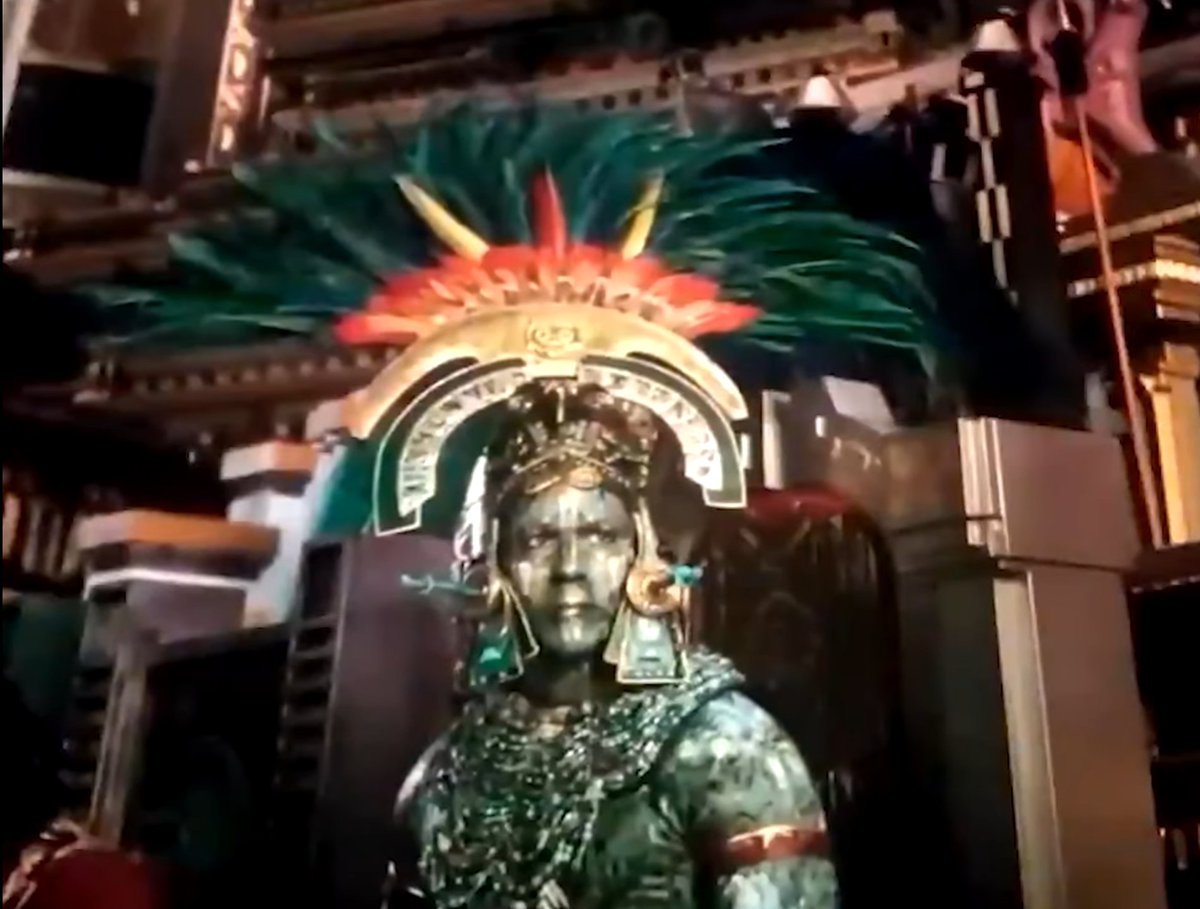
The Aztec God of the Sun and Wind, Knowledge and Learning, and the patron god of the Aztec priests, Quetzalcoatl is described in Mesoamerican folklore as the “feathered-serpent” whose power created the world we know today. In the comics, this Aztec god has a humanoid form, but the MCU seems to have opted to go all-in on the production budget and given him his feathered-serpent form for his appearance at the Council of Godheads. He is also a key member of the much smaller Council that appears in the comics, and so is this Mayan deity who is next on our list.
Itzamna Kauil
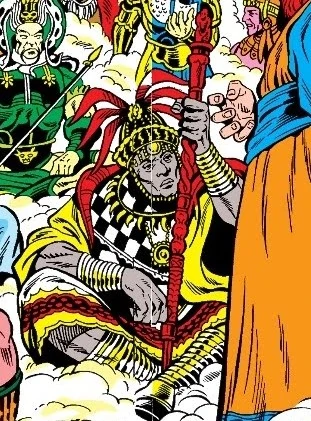
The creator-god of the Mayan culture, Itzamna Kauil is the Sky God equivalent of Zeus from Mesoamerican folklore. Known as the High King of the Ahau, he is the god of the sun and maize- two of things that are held most-sacred by the Maya peoples. He is also a patron of the arts and writing, which makes him rather similar to Apollo after a fashion.
Itzamna is a core member of the Council of Godheads in the comics, and the MCU as well, as he was one of the characters who got a full close-up during the entire fight scene that unfolded in Omnipotence City. There is no word on whether Marvel is looking to actively explore these rich, colourful pantheons once they are done setting up Phase 5 or something, but it wouldn’t surprise us if they did.
Unknown Maori Goddess
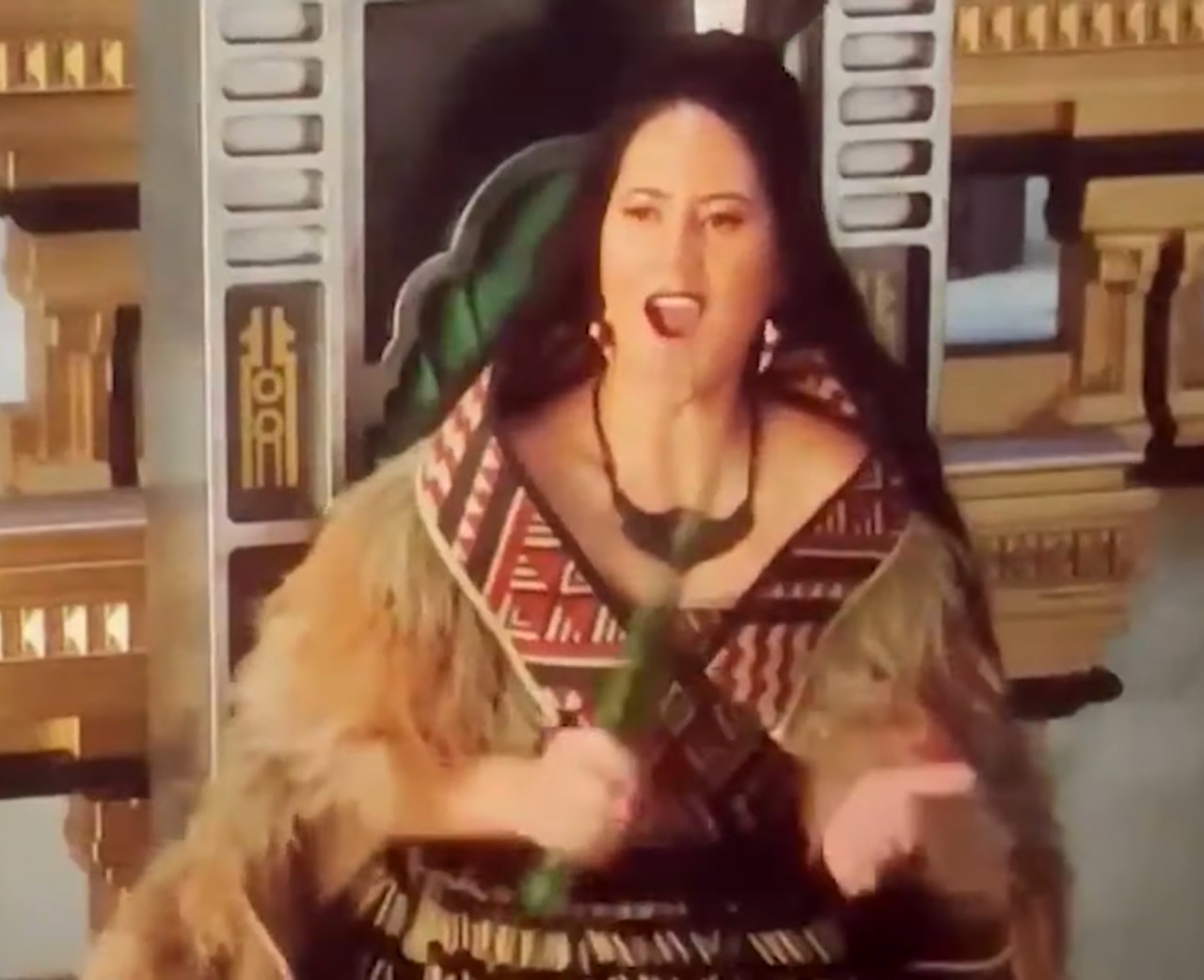
Speaking of surprises, we were pleasantly surprised to spot references to not one, but two Maori deities in Love and Thunder. The first comes from Thor himself, who refers to the Maori God of War in one of his rambling speeches to his allies, and the second is a Maori Goddess whom we can see getting out of her throne in Omnipotence City when everything goes tits up and Thor & Co. start wrecking shop.
We can’t identify her properly- it could be any one of the many Atua goddesses in existence- but we’ll go with Whaitiri, the Maori Goddess of Thunder, just because we could see Taika snickering to himself once someone figures out just what he has done with this selection. If you’ve figured it out, let us know in the comments!
Jademurai God
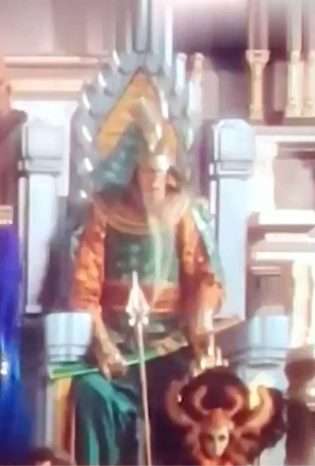
Kuni Hashimoto plays a rather elusive god in Love and Thunder; or should we say kami, because our best guess is that a Jademurai God is a “god from the Jade Court”, which would mean Hashimoto’s character is one of the Shinto deities from Japanese mythology. And frankly, nothing else would make sense either, given the fact that Kuni literally looks like the comic book version of Izanagi- God of the Sky- in his fleeting appearance.
Now, Thor fans will also know that this character showing up in a story specifically about dead gods is important because in the comics, the primordial Amastu-Mikaboshi- the very personification of evil in the universe- attacked every other pantheon in an attempt to re-assert his own dominance and it took the combined efforts of Thor, Izanagi and countless others to take care of this ancient threat. It would be interesting to see if the MCU takes such a direction, though we wouldn’t get out hopes up.
Lady of Elche/Elche Goddess
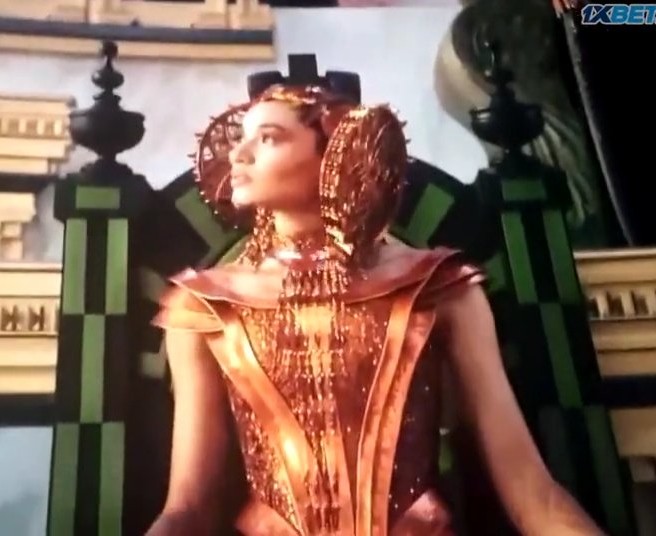
Well, Taika Waititi is nothing if not referential with his work, and with this entry, he managed to bring in such an obscure deity that we don’t even have a proper idea who she is in the first place! The credits list her as an Elche Goddess, but the famous bust of the Lady of Elche is one depicting an Iberian goddess, so which goddess is she exactly? But we suppose the doesn’t matter because this Elche goddess was most likely brought in just to fill up the galleries; as was the next character.
Goddess of the Dead
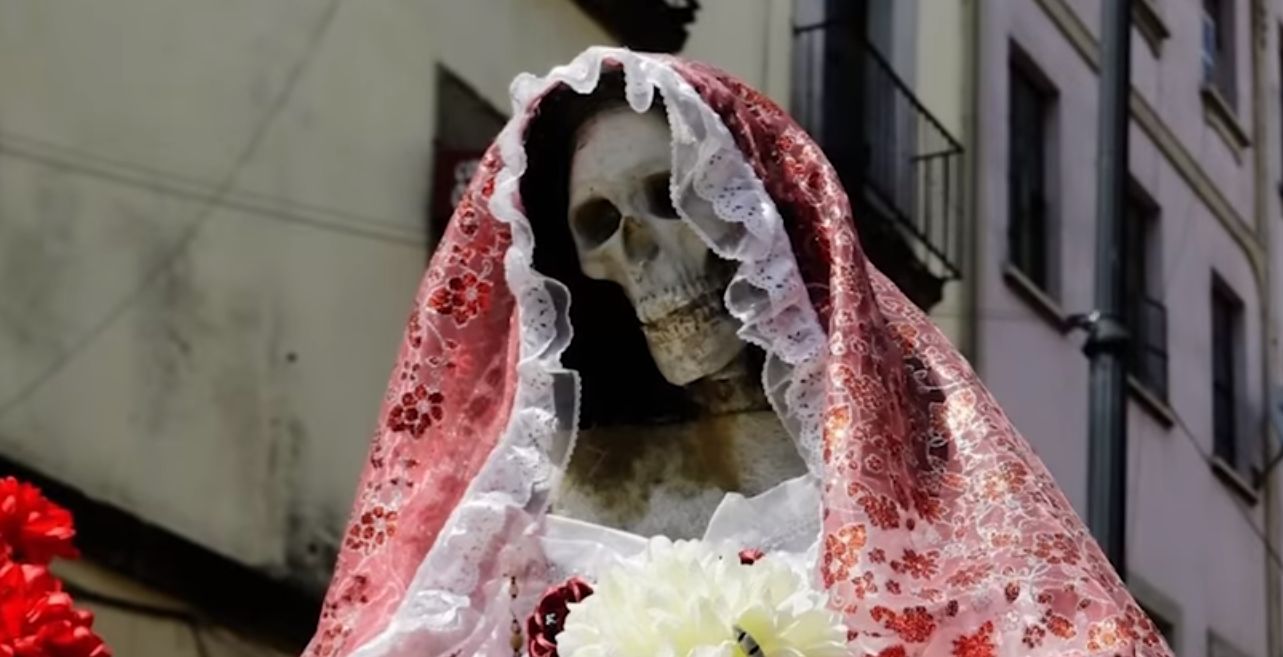
That’s all the information we get on this macabre deity, and we can’t even call Hela because, well, she’s dead already. We did take a few stabs at figuring out her identity and the best we could come up with was Santa Muerte- the colloquial name of the deity that inspired that Day of the Dead in Mexican culture- but that feels like a cop-out to us. But then again, we might be right because this is a Disney movie technically, and their directors like dropping Easter Eggs for Disney properties every now and then. Who do you guys think this Goddess of the Dead could be? Let us know in the comments below.
Flower God

Andrew Crawford becomes one of the rarest personalities- apart from James Gunn, of course- to have worked for both Marvel and DC in the film-space. He was spotted as part of the DCEU in Aquaman 1, where he played not one, but 2 separate Kings! Andrew was the man in the suits playing both Brine King and King Ricou in Jason Momoa’s first solo outing as Arthur Curry.
This time, he is portraying a God literally made out of Flowers, and it is about as trippy as you’d expect it to be. We’re actually kind of glad that Gorr put down Rapu real quick because we don’t think we could’ve spent a lot of time observing this weird, floral deity move about as if he were held together by literal wind from the look of things.
Fur God
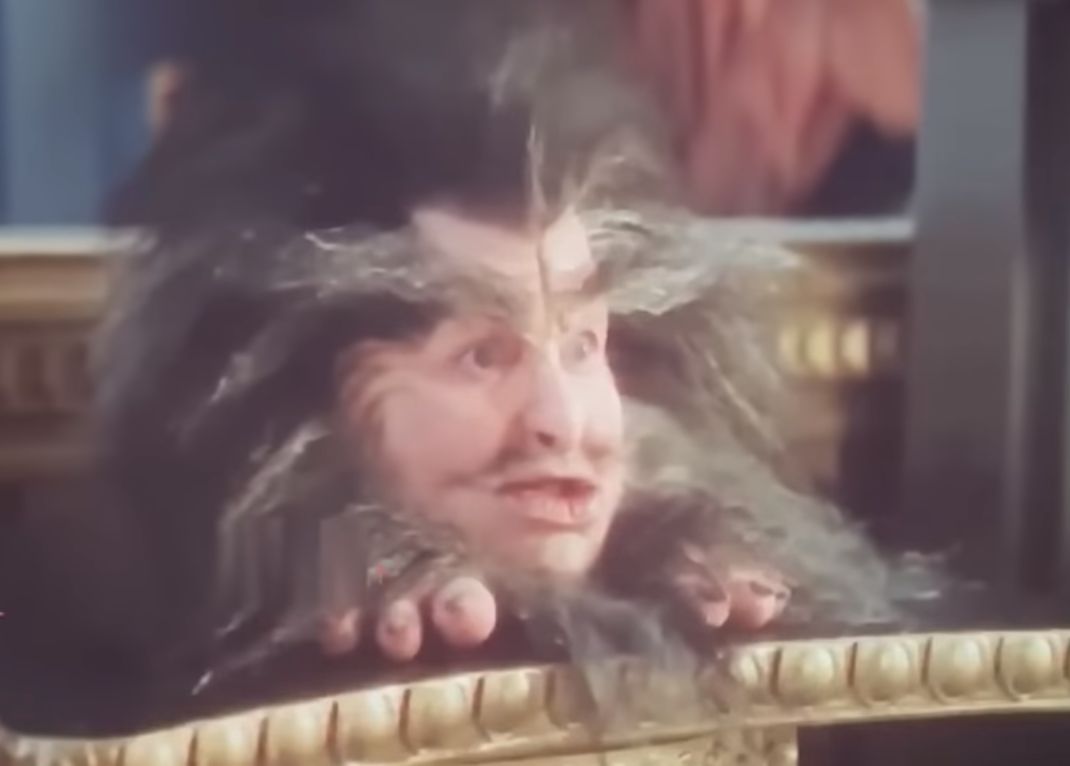
This god functions exactly as advertised; he is he patron god of fur. You heard that right, fur. All kinds, apparently, and he is also played by Stephen Hunt who played the affable Bombur in the Hobbit trilogy, so you know, he’s comedy perfection. The one scene where we see him, his head is literally at his feet, and we get that the Fur God was a novelty addition to get a pop out of the viewing audience, but the idea itself is something we morbidly adore. If only Cruella could’ve prayed to him instead, eh? Though we doubt it would’ve been any good, given the general nature of gods in the MCU.
Sequoia Queen & Oaken King
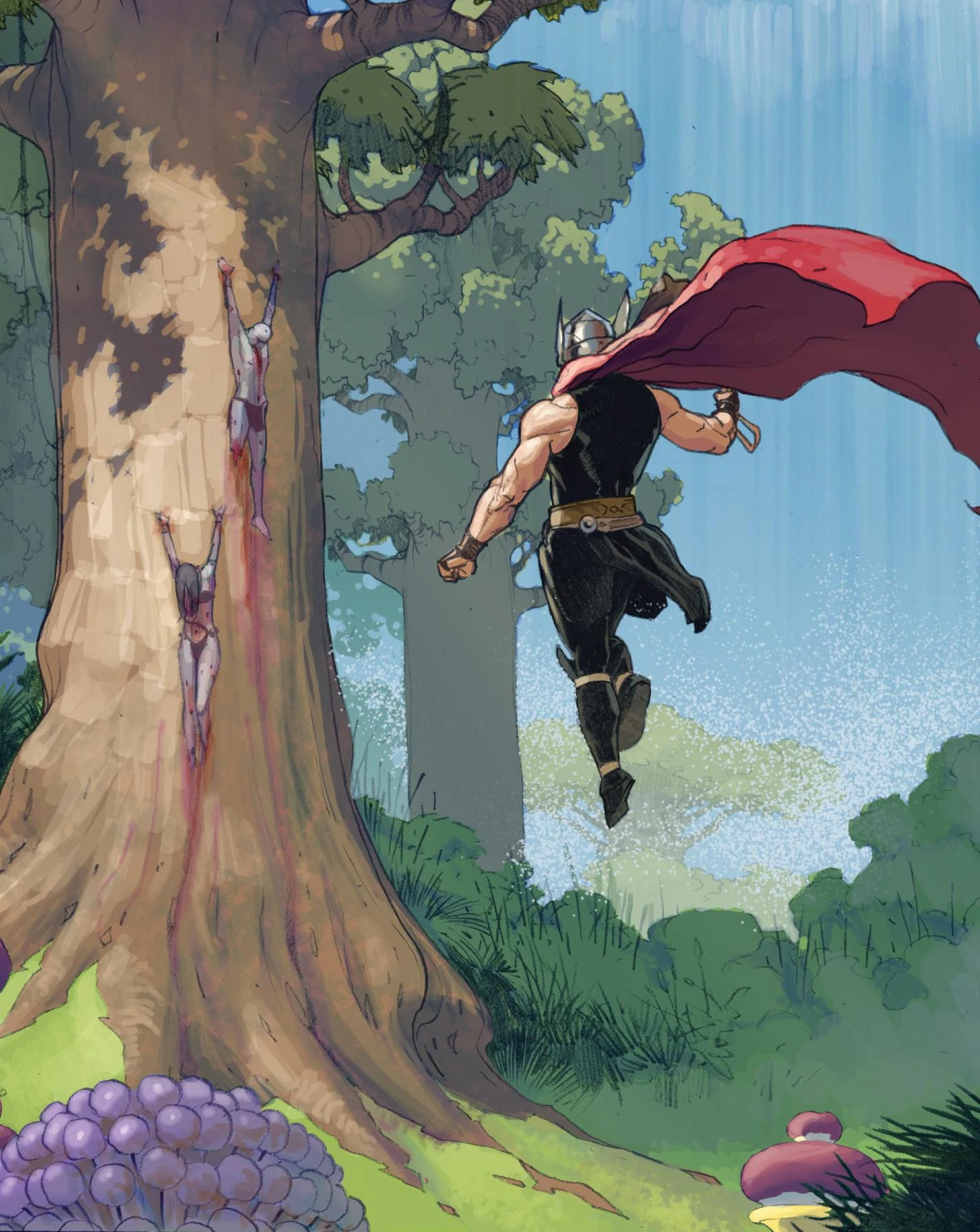
The Sequoia Queen and Oaken King are shown briefly when Thor is searching for Sif’s distress signal as two of Gorr’s victims. Their story in Thor: Love and Thunder is similar to the comics, though the timeline is significantly altered. In the movie, the couple was taken out presumably right after Gorr was done with Rapu and his Flowers, and we aren’t given any kind of information as to how long they had been dead.
In the comics, as the rulers of Glenglavenglade, the Garden Eternal, they were two of the first gods killed by Gorr the God Butcher, and Thor didn’t realise this until he entered the Hall of the Lost in search of Gorr and found his friends dead, 2000 years past, nailed to their world tree by the God Butcher and guarded by one of his Black Berserkers.
Not giving us all this background exposition actually worked out in the movie’s favour though, because with the rumours that nearly 4 hours of material ended up on the cutting floor, we don’t think keeping in this tiny detail would’ve mattered in the grand scheme of things.
Bao, The God of Dumplings

In what has to be the biggest two-fold corporate flex incorporated into any kind of film, Thor: Love and Thunder introduces us the Bao; the adorable God of Dumplings who is animated in the movie! Presumably, Bao has jurisdiction over all kinds of dumplings and not specifically Baos themselves, which means your Gyoza and/or momo is tasty only thanks to him. Thor seems to know Bao as he introduces him to Valkyrie, Jane and Korg, though they can’t stay too long to chat with him. Bao was clearly inspired by the Pixar film Bao, which has an anthropomorphic Bao bun at the heart of its story. Now that we’ve address Disney punch #1, let’s move to #2.
Ninny of the Nonny

Korg brought up his own god while doing one of his trademark Thor flashback re-tellings and we didn’t think we’d see the guy in all honesty; but if you know who plays Korg, you’d know that that was a stupid line of thought on our end. Ninny of the Nonny is the primary God who is worshipped by all Kronans.
He sits on a throne made out of scissors which looks a lot like the Iron Throne from Game of Thrones, and is also a reference to the rock-paper-scissor joke that Korg made in Thor: Ragnarok. Ninny of the Nonny is more of a punchline existence in the Council of Godheads, purely because there is no counterpart for him in the comics, and even his name makes fun of him. Ninny of the Nonny basically translates to the fool of fools if you want to dive into an archaic English lesson, but we don’t think you want that, so we’ll move swiftly onwards.
Gardener Celestial and Mad Celestial
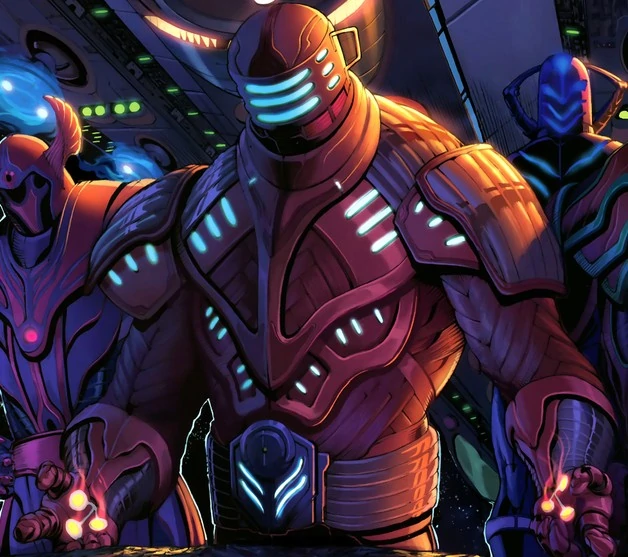
One of the more-obscure comic book references were the Mad Celestial and Gardener Celestial who were observing Thor escape with Zeus’ Lightning Bolt in the Goat Boat like a pair of excited and intrigued children. In the comics, a Gardener Celestial’s job is to plant new life on a planet using the Life Seed and then forcing it to evolve to its peak by using a Death Seed.
Apocalypse was one of the people who was granted the latter and ended up becoming, well, an apocalyptic existence for the rest of mankind when he surfaced from hs 5,000-year-long absence. A Mad Celestial is exactly what he sounds like; a Celestial infected with the disease of madness whose ultimate goals were corrupted into transforming from creation to destruction. In the comics, 4 of these guys travelled into the current iteration of the universe and attacked Galactus, who was only able to defeat them with the help of an adult Franklin Richards.
In the context of the MCU, Franklin Richards already exists in the multiverse somewhere; we know this thanks to Doctor Strange 2. Celestials have already shown that they aren’t what they say they are in the Eternals movie, and Galactus is seemingly set to enter the MCU finally, with his prospective arrival taking place in the new Fantastic Four film. That might be why these two particular types of Celestials were included in Thor: Love and Thunder.
MCU Elder Gods: Infinity, Eon, Uatu The Watcher, The Living Tribunal, Death & Arisham the Judge

The climactic battle between Thor, Jane, the Children of Asgard and Gorr takes place within a location called the Heart of the Universe, which is a deep cut from the comics. There, the heart is an artefact, but in the MCU, it has been turned into the location of a hall where we can see statues that represent the MCU’s incarnation of the Elder Gods. In the comics, the Elder Gods were a race of beings that populated the Multiverse with all of its nascent concepts before being replaced by lesser cosmic versions of themselves.
It looks like Kevin Feige and Co. have decided to turn them into a Council of Godheads before the Gods themselves existed, because the way this room is laid out, it looks more like a shrine than a hallway and contains the busts of some of the most-important cosmic figures in the entirety of Marvel Comics. First is Infinity, the counterpart of another cosmic being whom we will talk about in a bit.
Infinity is the embodiment of the very concept of space in the Multiverse, and is one of the top 3 cosmic-level deities in existence alongside her twin brother. Eon is the one-eyed cosmic being associated with the passing of time in Marvel and is the creator of the Quantum Bands.
He is the one who showed the first Captain Mar-Vell the truth about the Celestials and Thanos and made him the “Protector of the Universe”, though that story is very different in the MCU. What isn’t is the fact that Eon might just show up in Ant-Man: Quantumania or at least be brought up during its events because it is very possible that the Quantum Bands are in the Quantum Realm, and that Ant-Man and Co. will get their hands on it in that movie; though they might not be glad they did. Next is everyone’s favourite Giant Baby-Man in a Cape, Uatu the Watcher.
Part of a race of cosmic beings created to watch over the Multiverse and its progression, the What If… series did a great job of setting him up as a protective force before the movies sent everything to absolute hell, so you can expect Uatu to show up in future movies as we build up to the Kang Multiverse War. The Living Tribunal is the strongest entity in the Multiverse, being the representation of existence itself, and serves as the ultimate Cosmic Judge.
We’ve already met him once during Dr. Strange’s tumble through realities during Multiverse of Madness, and now we’ve seen his three-faced head again. The Living Tribunal is going to be key to the events of Phase 4 and 5 of the MCU, and we can’t wait to see him in action proper. One of the most highly-anticipated comic book characters that never crossed over to the big screen was the cosmic entity Death, who by rights should have been introduced in the first Avengers film if we’re talking about maintaining authenticity here.
But the fact that Lady Death wasn’t included in the movies actually works out in Marvel Studios’ favour because they now have a cosmic bullet in their chamber, ready to fire off whenever they need to create a reality-ending conflict. Though it would’ve been great to see her and Thanos in action because they are our personal favourite toxic couple, it’ll be just as interesting to see Lady Death have a go at things solo.
And you never know; with Deadpool potentially crossing into the MCU, we might just get a deadly relationship after all! And finally, the last statue we see in the Heart of the Universe is that of Arishem the Judge, and this is where we would like to call BS on everything this Celestial told Sersi at the end of the Eternals film, because the existence of this room itself is proof that Arishem didn’t create everything; in fact, she’s practically small-fry when it comes to the cosmic order of things, and the Prime Celestial will have a LOT of explaining to do should the rogue Eternals who departed Earth ever come across the deeper secrets of the Universe, which is something we expect to see in Eternals 2. Now that we have addressed all of the MCU Elder Gods, let’s get to the one we actually get to meet!
Eternity
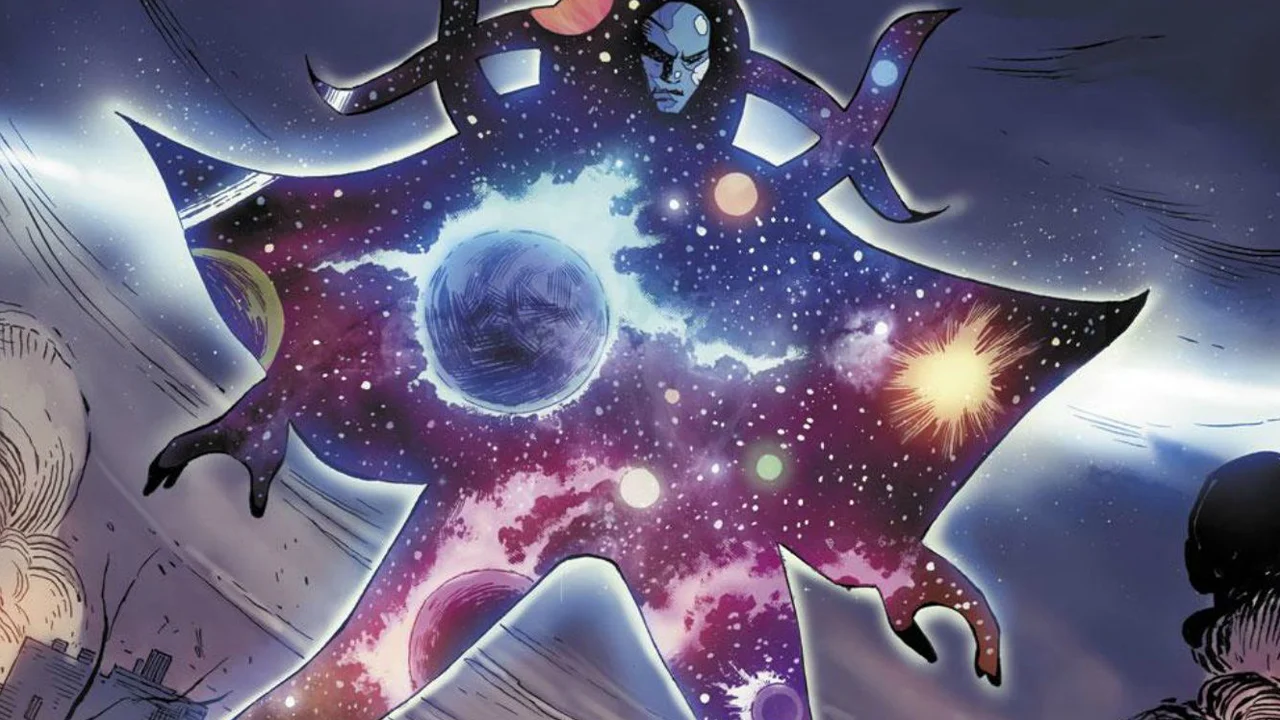
How do you fit a multi-issue, multi-title storyline into one film that barely runs over 2 hours? You introduce plot armour in the form of one of the strongest cosmic beings in the universe, of course! If Gorr the God Butcher had taken the same path that he did in the comics, he’d be killing gods for thousands of years to come. So Taika gave him the easy way out; kill a few dozen gods and then go straight to the altar of Eternity to get a wish granted, which, knowing his motivation throughout the film, shouldn’t come as a surprise.
Eternity in the comics is the embodiment of time itself, hence the name. He is Infinity’s twin brother and is quite literally timeless, existing at all points in time simultaneously. He was first referenced in Guardians of the Galaxy Vol. 2 when Peter Quill, enticed by Ego’s powers, glimpsed into his Grand Plan and saw Eternity at its core. Gorr became the first person in the MCU to reach the altar of Eternity, which is why he was given the blessing of asking for a wish from the cosmic being.
Initially, he was going to wish for the death of all the gods in the universe, but having been freed from the corruption of the Necrosword and being on the verge of death, he wished to bring his daughter back to life instead. Eternity’s personal realm is quite similar to the Soul Stone’s innate dimension, and his “real form” is merely an outline of his comic book design in meditation and filled with a cosmic star-system instead of solid features.
Given the scale of Eternity’s powers and the fact that his wish-granting ability was a one-shot deal, we’re sceptical of seeing him again in the MCU, though we wouldn’t be surprised if he showed up again; which brings us to the very being that Eternity brought back to life and the last god on our list.
Love

Gorr’s daughter, who served as the catalyst for him becoming a God Butcher, was turned into a goddess herself when she came back to life, thanks to the fact that her rebirth was facilitated by Eternity. Love is now one of the strongest beings in the entire Multiverse, being capable of wielding Stormbreaker without even hitting adolescence.
And what’s more, is that it’s hinted that she now wields the Power Cosmic, because if you look at her eyes, you can see a purple glow coming off of them which can only be related to this mystical concept from the comics. We could be wrong, but that would also make it the perfect reason for a future Galactus invasion, as he could attack Earth to take Love’s power and end up deciding to devour it because of its raw cosmic existence as the centre of all sentient life.
But until that point in time comes, Love is going to be going off on uncountable adventures alongside her adoptive father Thor, because it turns out, the title of this movie isn’t about themes, it’s the literal name of their godly father-daughter duo! Across the universe, whenever evil starts raring its head, it is soundly defeated by the team known as Love and Thunder.
Marvelous Verdict
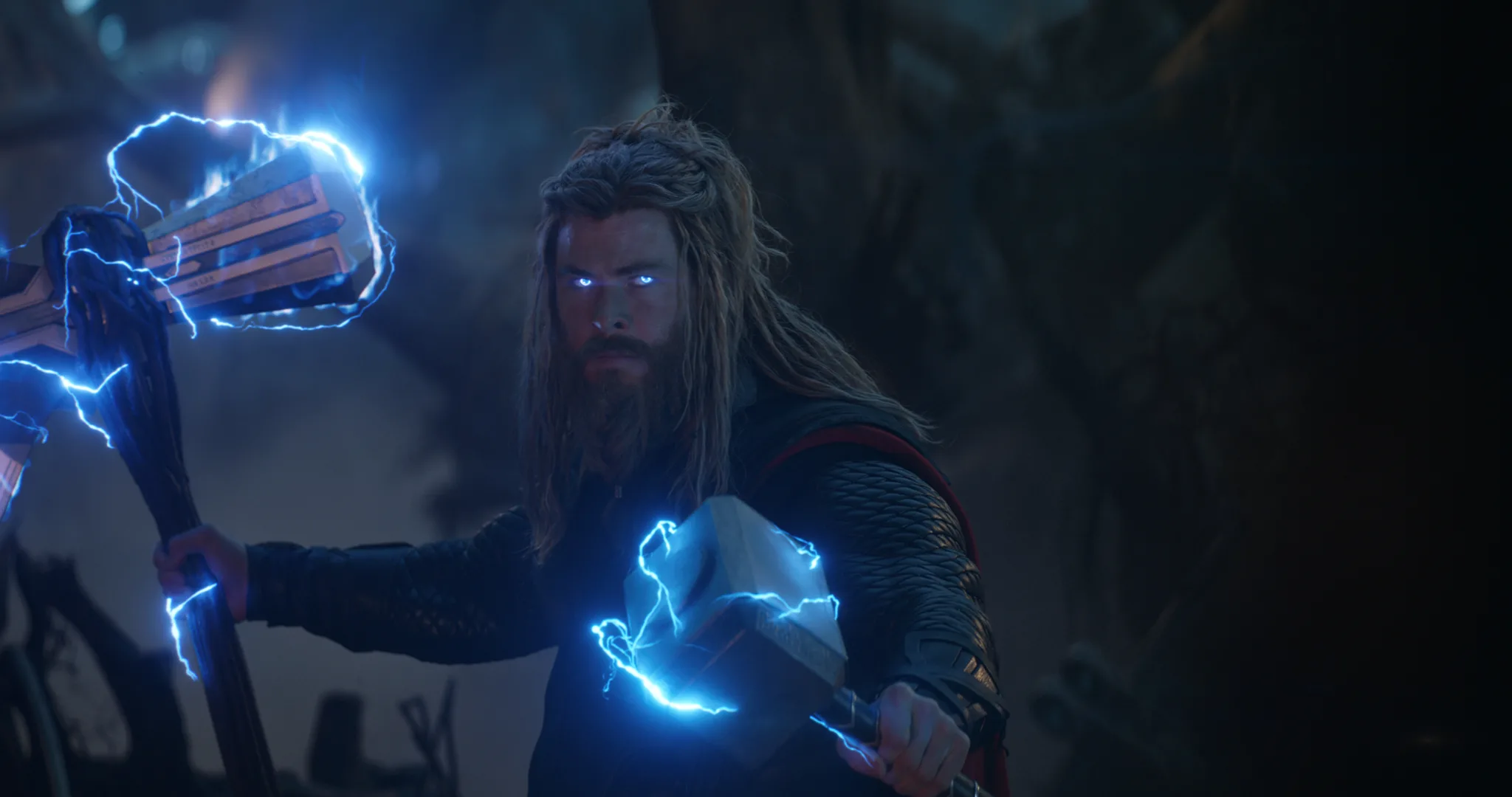
And that’s a wrap for this list! Close to 50 cosmic deities and figures either appeared in-person, were named, or shown in a position of prominence in Thor: Love and Thunder and that doesn’t even account for everyone in Omnipotence City! It’s safe to say that this movie has broken all sensibility of power scaling because in a movie that has characters as weak as Korg and as strong as Eternity, you can’t really guess who stands where and why; you can only enjoy the ride.
We hope you felt exactly that way going through this video, and want to know which god was your favourite out of them all; let us know in the comments, and we will see you soon with some more Marvelous Content.
